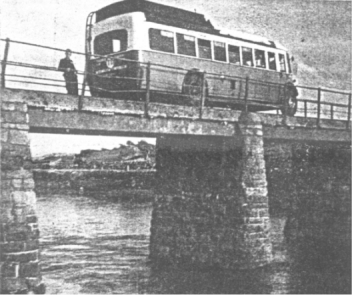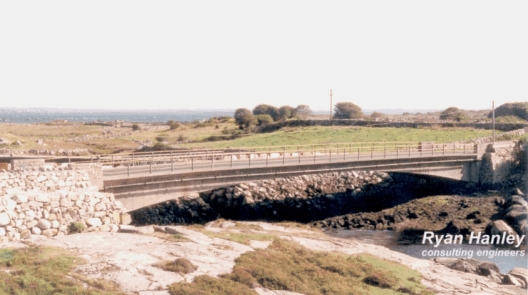Flannery Bridge spans the Kilkieran Estuary on the main Maam Cross - Carna road (R340) on the north-west shore of Kilkieran Bay in County Galway. It provides the nearest approach to the district surrounding the villages of Kilkieran and Carna. The site of the bridge is on a tidal creek having a maximum tidal range of 13' (3.960 m) and a minimum of 6' (1.830 m). The bridge has been built or rebuilt three times so far. The original (1887) bridge, which was of stone pier and iron girder construction, was named after Fr. Thomas J. Flannery (1853 - 1891), parish priest of nearby Carna, who was instrumental in the construction of this bridge, another bridge linking Mweenish Island to the mainland at Carna, and two national schools in the parish at Loughaconeera and Mweenish Island. He also lobbied strongly for government investment in local forestry, piers and the railway between Galway and Clifden. The old stone bridge was still reportedly in excellent condition when demolished in 1954, but since it had a carriageway of only 6' 6" (1.980 m) it was single lane and unsuitable for motorised traffic. The Second Flannery Bridge (1954) The 1954 replacement bridge was initially conceived as a triple span of three barrel arches, spandrel filled, in normal reinforced concrete. Ultimately, a proposal to replace it with a single span pre-stressed concrete arch was accepted. The span was 180' (54.865 m) and the carriageway was 18' (5.485 m) with two footpaths each 4' 6" (1.370 m). The bed and foundations are massive granite. The bridge was constructed using a total of 572 cubic yards of concrete, 17 tons of high tensile steel, and 22 tons of mild steel. The total length of pre-stressing wire was 33 miles formed into 14,742 feet of cables. The complete time for the contract was just over seven months, and the total cost of the structure was £19,043. They had certain difficulties on the job, one of the biggest being haulage. The water for the site-batched concrete had to be hauled in tanks for a distance of four to five miles, and the aggregates came from fifty miles away. Initially, it was thought that the local stone would crush suitably for the aggregate, but unfortunately the tests had not come up to specification. A technical paper describing the construction of the new bridge was presented by two of the engineers, D. O'Leary and C. Murphy, to the Institution of Civil Engineers of Ireland on 7th February 1955. This has been recorded as the first paper on a prestressed concrete bridge in Ireland. From the designer's viewpoint, the bridge was the first pre-stressed statically indeterminate bridge in Ireland. The chief design engineer, Nicholas O'Dwyer, remarked that the site was extraordinarily exposed and dangerous by reason of the gusty winds. He also remarked that the Connemara men stood up well to the requirements of the job, and some of them displayed extraordinary intelligence and pride in their work, which was a great help. Upon completion, the bridge was tested with six trucks loaded with rock. The Third Flannery Bridge (2000) At the close of the twentieth century, imperfect grouting of the prestress tendons encouraged corrosive degradation of the reinforcement, and the structure showed signs of distress. Finally, in 1999, the slender concrete arch was replaced by a triple span structure utilising precast concrete bridge beams and a reinforced concrete deck. Demolition of the 1954 bridge commenced on 25th January, and the new bridge was opened for traffic on the 25th September. The official opening of the bridge was staged on 4th February 2000, and the bridge was blessed jointly by Fr. Padraig Audley PP Carna, and Fr. Michael Flannery PP Inverin and, coincidentally, grand-nephew of Fr Thomas Flannery. The bridge, which has now been opened successively in 1887, 1954 and 2000, is believed to be the only bridge in Ireland to have been built or rebuilt in three successive centuries.


